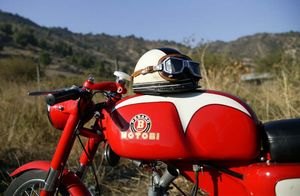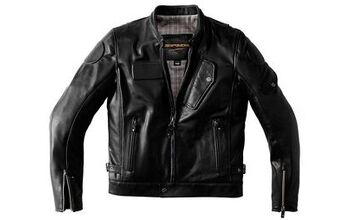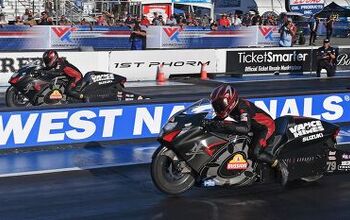Cafe Racers in Chile
It's 7:00 AM and the sun is beginning to fill Chile's Colchagua Valley with a soft, golden light. Not even the dogs are stirring from where they huddle in the sleepy central plaza as four vintage motorcycles with an average age 42.5 of years are wheeled before the Santa Cruz Plaza hotel. Fuel taps are opened and other adjustments made as the salmon fingers of dawn recede in the sky and yellow sunlight floods into the plaza. A few quick kicks and a 1960 Panther T15 and a 1959 Triumph T100 roar into life.
Between my legs I have a beautiful red 1966 Motobi 175. The kick starter shows no interest in fulfilling its function so I engage second gear and run the Motobi down the street, let out the clutch and bump start it to life. As the engine catches, a little throttle turns the fragile sputter into a full-blooded Italian roar, revving harder to warm up the engine as I circle around back to the hotel.
"This lady was built to run," Tomas says, pausing to catch his breath between kicks, "but she doesn't like waking up in the morning, but when she does she is incredible." With another kick the engine takes and deafening roar howls out of the tail pipe.
With four of us revving, an incredible throaty sound reverberates around the square, a cacophony that is out of time and out of place in the small agricultural town in the heart of Chile's wine region. First gear is engaged and one by one we file out from the hotel in a procession of noise into the open country of one of Chile's most beautiful wine valleys, 130 km south of capital Santiago.
The roads are deserted this early in the morning and as we accelerate up to 90 km/h, the crisp morning air floods my visor-less eyes with tears to the point that I cannot see. I tilt my head back to let the wind rush clear them out and whoop for joy as golden fields, verdant green rows of vines and cacti-studied hills pass by. This is motorcycle touring in an elemental form: low distance, simple roads and machines from another era. Vintage motorcycle tours is a concept developed by the Café Racer motorcycle museum (www.caferacer.cl) in Santiago, a
private collection assembled by Francisco Bascunan that numbers over 80 fully restored machines. On any weekend of the year without rain, relaxed pace day trips are offered for groups numbering from four to seven people, using a selection of motorcycles from the collection with fine dining at various vineyards to give motorcycle enthusiasts a unique way to see the region. "There is a public that wants to do this and it is a unique way to do a wine tour," says tour developer Tomas Bascunan. The tours also allow the museum to keep the motorcycles in use and generate an income stream for the maintenance and restoration of its fleet.
Once warmed up the Motobi runs without trouble and the vineyards, pastures dotted with grazing livestock, golden fields of maize and cereals, and low farm buildings drift by and the smells of the country fill my nose. Horse locomotion is common and we pass several horse-drawn carts and mounted huasos - Chilean cowboys - riding in poncho and broad-brimmed hat, with knee-high black leather boots and spurs that look like medieval weaponry. The people are friendly and often wave as we pass, turning with curiosity at the shining antiquities we are riding.
The motorcycles ride differently compared to modern machines. Changing gears is an action completed without thinking, but these machines have the gear change on the right and footbrake on the left, the reverse of the set-up on modern bikes. Trying to override an instinctive left-foot gear change movement was like having to learn to ride all over again and initially I kept hitting the brakes in error.
"That is why we offer a lesson on how to ride vintage motorcycles before we start the tour," Bascunan said.
The riding is at an easy pace and only for a couple of hours at a stretch, giving ample time to come to grips with the different performance characteristics. As we pass fields of grapevines and farmhouses I give myself a rudimentary education of vintage braking systems. The front drum brake comes on rather spongy and the Motobi's engine splutters as I change and slow down. More revs are needed, but braking while maintaining revs with the same hand is an art in itself. I compensate with the spongy footbrake and lock-up the back wheel. The children playing with their dogs in the dust wave as I pass, mistaking the grimace on my face for a smile.
Riding vintage motorcycles requires a completely different mentality to adjust to the different riding requirements and to stop doing the things that are common in modern motorcycling. I look for mirrors and try to change up into the fourth and fifth gears that the Motobi does not have, but with the rougher engine sound filling my ears, my riding style adjusts and I start my actions sooner than normal to allow for the extra time they take to stay in control, warming to how much fun it is.
Control is relative. A dog ran out in front of me from nowhere (not uncommon in the country) and instinct had me stepping on the gear-changer not the brake pedal while I grabbed at the soft front brake. Somehow the dog kept out from my front wheel.
With that bit of excitement out of the way I began to enjoy the Colchagua Valley, which is agricultural and typically rural and Chilean. The valley runs 120km from the backbone of the Andes to the Pacific Ocean and is bounded by two spurs of the Andes mountains to the north and south some 35km apart. With a Mediterranean climate in addition to being a paradise for winemakers, it is perfect country for motorcycling with low traffic volume and a combination of mountainous climbs leading to scenic views before descending into valley straights for a burst of speed.
| THE BIKES |
| 1962 BSA Goldstar DBD34 A true British cafe racer, whose four speed, 499cc, air-cooled single cylinder engine can reach a maximum speed of 177 km/h. 1959 Triumph T100 A three speed, two cylinder, four-stroke air-cooled 498cc British beauty with a maximum speed of 150 km/h. 1960 Panther T15 A British three speed, air-cooled, four stroke 348cc motorcycle with a maximum speed of 120 km/h. 1966 Motobi 175 An Italian three speed, four stroke, air-cooled 174cc engine, with a maximum speed of 120 km/h. |
Heading towards the small village of Nancagua, we start to climb part of a mountain. The steep gradient quickly has the Motobi running out of steam and I work the gears up and down trying to maintain momentum, but with only three gears available, the task has a certain futility to it and I resign myself to a slow climb to the top and feel more than a little envious of Tomas as he bats past on the more powerful BSA Goldstar wearing a grin that extends from one side of his half-cup helmet to the other. Climbing out of the mountain's shadow on the final bend I stop to see a breathtaking expanse of the valley bathed in sunlight spread out before me, and Tomas now a dot switching back and forth on the road that drops away before me.
Descending, I ease the motorbike into the corners before releasing the brakes to let it run on under its own momentum towards the next bend as the engine putt-putts under the lack of work, gently checking my speed with the brakes, finally circling around into the valley again under the gaze of the Virgin Mary perched on top of a bluff, guiding me to my lunch stop.
VINEYARD LUNCHWe pull into the Viu Manent winery that hosts the La Llaveria restaurant for al fresco dining in the courtyard that overlooks a beautiful garden and fountain. Outside, house-drawn carriages wait under the shade of a copse of trees to convey visitors through the vineyards that we had just ridden through on the motorcycles.
On the menu are big cuts of steak or tuna, or Chilean national dish pastel de choclo. The food is excellent, and as this is the end of the ride, a little wine as well. The grand old ladies parked outside prefer a different vintage and like drinking the rough stuff, aviation fuel, because it is leaded.
| If you go... TOURS |
| The Café Racer Museum will begin offering fully supported, guided tours in Spanish, English, Portuguese and Italian from September 2005. Tours include motorcycle rental, accommodation, insurance, and support vehicle. Training on the more difficult to ride motorcycles can be arranged in Santiago prior to tour departure. Two-day tours are available any weekend without rain and include motorcycle rental, transfers, insurance, vintage motorcycle riding lesson, hotel, food, visits to a winery, Casa de los Espiritus and Colchagua Museum. For further details contact: Tomas Bascu–an SANTA CRUZ Wine tourism is a recent phenomenon in the valley and is centered on Santa Cruz where the majestic Santa Cruz Plaza hotel (www.hotelsantacruzplaza.cl) has grown and been extended to cater for the growing number of visitors. The hacienda style hotel has 44 rooms, two restaurants and a swimming pool. The hotel's owner is also the patron and developer of the adjacent Colchagua museum (www.museocolchagua.cl) that has an impressive collection of over 5,000 exhibits showing the history of Chile from prehistoric times, through the Spanish conquest, to the present day. Espiritus de Colchagua makes artisanal fruit and herb infused liqueurs using aguardiente grape brandy. The adobe construction house has an inner courtyard filled where a wide variety of plants grow, most of which provide ingredients for the infusions. A tour and tasting explains how over 20 varieties are created including raspberry, blackcurrant, native red berry murta and boldo, a medicinal evergreen shrub native to South America. The Café Racer Museum in Chilean capital Santiago is a private collection of over 80 fully restored motorcycles, 45 of which are on public display in the exhibition hall. The grand old lady of the collection is a 1906 Moto Reve, a Swiss-made motorcycle built into a BSA bicycle frame, and the baby is more like the sexy beasts we know today, the 1985 Ducati NCR 1985. The roll call of the collection includes marques such as Ducati, BSA, Triumph, Norton, Moto Guzzi, Vespa, Panther, NSU, MV Agusta, Parilla, AJS, Motorb, Adler, Capriolo, Morini, Gilera, Coventry Eagle and Husqvarna. Restoration occurs on site. The workshops are not open to the public but viewing panels in the walls allow visitors to get a glimpse of the restoration process. |
More by Paul Harris



































Comments
Join the conversation